Chichester
Chichester (/ˈtʃɪtʃɪstər/) is a cathedral city in West Sussex, in South-East England.[4] It is the only city in West Sussex and is its county town. It has a long history as a settlement from Roman times and was important in Anglo-Saxon times. It is the seat of the Church of England Diocese of Chichester, with a 12th-century cathedral.
| City of Chichester | |
|---|---|
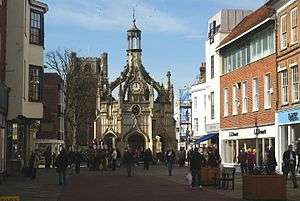 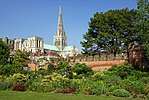 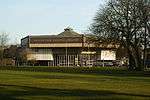 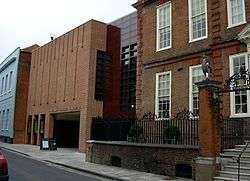 Clockwise from top: Market Cross seen from East Street, the Festival Theatre, Pallant House Gallery, the Guildhall, and Cathedral Church of the Holy Trinity | |
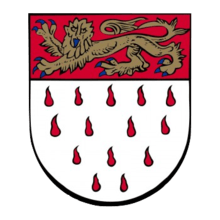 Coat of arms | |
 City of Chichester Location within West Sussex | |
| Area | 10.67 km2 (4.12 sq mi) [1] |
| Population | 26,795 [2] (2011 Census) |
| • Density | 2,225/km2 (5,760/sq mi) |
| Demonym | Cicestrian[3] |
| OS grid reference | SU860048 |
| • London | 54 miles (87 km) NNE |
| Civil parish |
|
| District |
|
| Shire county | |
| Region | |
| Country | England |
| Sovereign state | United Kingdom |
| Post town | CHICHESTER |
| Postcode district | PO19 |
| Dialling code | 01243 |
| Police | Sussex |
| Fire | West Sussex |
| Ambulance | South East Coast |
| UK Parliament | |
| Website | City Council |
The city is a hub of several main road routes, and has a railway station, theatre, hospital, schools and museums. The River Lavant runs through, and partly beneath, the city.
History
Roman period
The area around Chichester is believed to have played significant part during the Roman invasion of AD 43, as confirmed by evidence of military storage structures in the area of the nearby Fishbourne Roman Palace.[5] The city centre stands on the foundations of the Romano-British city of Noviomagus Reginorum, capital of the Civitas Reginorum. The Roman road of Stane Street, connecting the city with London, started at the east gate, while the Chichester to Silchester road started from the north gate. The plan of the city is inherited from the Romans: the North, South, East and West shopping streets radiate from the central market cross dating from medieval times.
The original Roman city wall was over 6 1⁄2 feet (2.0 m) thick with a steep ditch (which was later used to divert the River Lavant). It survived for over one and a half thousand years but was then replaced by a thinner Georgian wall.
The city was also home to some Roman baths, found down Tower Street when preparation for a new car park was underway. A museum, The Novium, preserving the baths was opened on 8 July 2012.
An amphitheatre was built outside the city walls, close to the East Gate, in around 80 AD. The area is now a park, but the site of the amphitheatre is discernible as a gentle bank approximately oval in shape; a notice board in the park gives more information.
In January 2017, archaeologists using underground radar reported the discovery of the relatively untouched ground floor of a Roman townhouse and outbuilding. The exceptional preservation is due to the fact the site, Priory Park, belonged to a monastery and has never been built upon since Roman times.[6]
Anglo-Saxon period
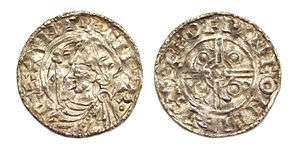
According to the Anglo-Saxon Chronicle it was captured towards the close of the fifth century, by Ælle, and renamed after his son, Cissa. It was the chief city of the Kingdom of Sussex.
The cathedral for the South Saxons was founded in 681 at Selsey; the seat of the bishopric was moved to Chichester in 1075.
Chichester was one of the burhs (fortified towns) established by Alfred the Great, probably in 878–879, making use of the remaining Roman walls. According to the Burghal Hidage, a list written in the early 10th century, it was one of the biggest of Alfred's burhs, supported by 1500 hides, units of land required to supply one soldier each for the garrison in time of emergency. The system was supported by a communication network based on hilltop beacons to provide early warning. It has been suggested that one such link ran from Chichester to London.[7]
Norman period
When the Domesday Book was compiled, Cicestre[8] (Chichester) consisted of 300 dwellings which held a population of 1,500 people. There was a mill named Kings Mill that would have been rented to local slaves and villeins. After the Battle of Hastings the township of Chichester was handed to Roger de Mongomerie, 1st Earl of Shrewsbury, for courageous efforts in the battle, but it was forfeited in 1104 by the 3rd Earl. Shortly after 1066 Chichester Castle was built by Roger de Mongomerie to consolidate Norman power.[9] In around 1143 the title Earl of Arundel (also known as the Earl of Sussex until that title fell out of use) was created and became the dominant local landowner. In 1216, Chichester Castle, along with Reigate Castle, was captured by the French, but regained the following year, when the castle was ordered to be destroyed by the king.[10] Between 1250 and 1262, the Rape of Chichester was created from the western half of Arundel rape, with the castle as its administrative centre.[11]
Medieval to modern times
At Christmas 1642 during the First English Civil War the city was besieged and St Pancras church destroyed by gunfire.[12] A military presence was established in the city in 1795 with the construction of a depot on land where the Hawkhurst Gang had been hanged. It was named the Roussillon Barracks in 1958.[13] The military presence had ceased by 2014 and the site was being developed for housing.[14]
Governance

Historically, Chichester was a city and liberty,[15] thereby largely self-governing. Although it has retained its city status, in 1888 it became a municipal borough, transferring some powers to West Sussex administrative county. In 1974 the municipal borough became part of the much larger Chichester District. There is a city council[16] but it only has the powers of a parish council; control of services is largely in the hands of Chichester District Council and West Sussex County Council.
The City Council consists of twenty elected members serving four wards of the city – North, South, East, and West.[17]
The Council House on North Street dates from 1731;[18] prior to this the City Corporation had met in Chichester Guildhall. In addition to its own council offices, those of the Chichester District and the West Sussex County Council are located in the city. The current MP for the Chichester Constituency is Gillian Keegan.[19]
Chichester has an unusual franchise in its history. Chichester's residents had enjoyed political enfranchisement for 300 years before the 19th century Reform Bills expanded the right to vote for members of Parliament to include most ordinary citizens. However, when the mayor restricted the vote solely to Freemen in the election of 1660 for the Convention Parliament that organised the restoration of the monarchy, the House of Commons noted that "for One-and-twenty Parliaments, the Commonalty, as well as the Citizens, had had Voice in the electing of Members to serve in Parliament; and that thereupon the Committee were of Opinion, that the Commonalty of the said Borough, together with the free Citizens, have Right of Election"[20] and overturned the election, seating instead the candidate elected by the more-inclusive Commonality of Chichester, and jailing the mayor for two weeks for contempt because of his wilful denial of the ancient rights.
Geography

The City of Chichester is located on the River Lavant south of its gap through the South Downs. This winterbourne for part of its course now runs through the city in underground culverts.[21] The city's site made it an ideal place for settlement, with many ancient routeways converging here. The oldest section lies within the Medieval walls of the city, which are built on Roman foundations.[22]
The Chichester Conservation area, designated for its architectural and historic interest,[23] encompasses the whole of the Roman town, and includes many Grade I and II listed buildings. Further to the north lies the separate conservation area around the former Graylingwell Hospital, and to the south, the Chichester Conservation Area has been extended recently to include the newly restored canal basin and part of the canal itself. The Conservation Area has been split into eight 'character' areas, based on historic development, building type, uses and activities.
Climate
Chichester has a maritime climate. With its position in southern England, Chichester has mild winters and cool summers. West Sussex has high sunshine levels compared with other parts of the UK with around 1,900 hours annually.[24]
Economy

The city has a tourist industry.[25] Several marinas are situated in the area together with related industries. A recent government study suggested that the area has a lot of employment with the public sector (as well as within the tourism and leisure industries), with a growing number of self-employed people in the area.[26]
Buildings
The Butter Market in North Street was designed by John Nash, and was opened in 1808 as a food and produce market. In 1900, a second storey was added to the building, originally housing an arts institute. The building has recently been renovated.
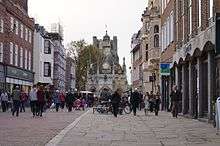
The Corn Exchange in East Street was built in 1833, one of the first in the country.[27] From the 1880s it was used for drama and entertainment and became a cinema from the 1910s.[28] An attempt to convert it to a bingo hall was refused in 1977.[29] As it could not be converted to a multiplex it was closed on 9 August 1980.[29] It remained closed and unused for six years until the front was opened as a fast food restaurant and the rear converted for offices.[29][30] From 2005 the front had been used by a clothing retailer.[31]
Chichester Cross, which is a type of buttercross familiar to old market towns, was built in 1501 as a covered market-place,[32] stands at the intersection of the four main roads in the centre of the city.
Religion
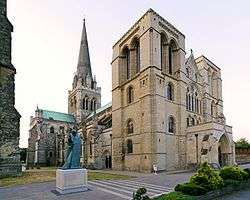
Chichester Cathedral, founded in the 11th century, is dedicated to the Holy Trinity, and contains a shrine to Saint Richard of Chichester. Its spire, built of the weak local stone, collapsed and was rebuilt during the 19th century. In the south aisle of the cathedral a glass panel in the floor enables a view of the remains of a Roman mosaic pavement. The cathedral is unusual in Britain in having a separate bell tower a few metres away from the main building, rather than integrated into it. Within the cathedral there is a medieval tomb of a knight and his wife, the inspiration of the poem "An Arundel Tomb", by Philip Larkin. A memorial statue exists of William Huskisson, once member of parliament for the city, but best remembered as the first man to be run over by a railway engine. Leonard Bernstein's Chichester Psalms were commissioned for the cathedral. The statue of St Richard (pictured left) is by the sculptor Philip Jackson. There are further Philip Jackson sculptures outside the Chichester Festival Theatre and St Richard's Hospital in Chichester.
In addition to the cathedral there are five Church of England churches, St Richard's Roman Catholic church and nine religious buildings of other denominations.[33] Redundant churches include the Grade I-listed St John the Evangelist's Church, an octagonal white-brick proprietary chapel with an impressive three-decker pulpit.[34][35]
Transport
Chichester is the hub of several main roads. The most important of these is the A27 coastal trunk road (connecting Eastbourne with Southampton) which passes to the south of the city. The A27 connects Chichester to the M27, M3 and M275 motorways. The secondary coastal road, the A259, which began its journey at Folkestone in Kent, joins the A27 here and ends in Havant to the west. Both those roads make east–west connections. Three roads give Chichester access to the north: the A29 to London joins the A27 several miles to the east of the city; the A285 runs northeast to Petworth and beyond; and the A286 runs northwards towards Haslemere, Surrey.
Chichester railway station, on the West Coastway Line, has regular services to Brighton, London Victoria via Gatwick Airport, Portsmouth and Southampton. In the past there was a branch line to Midhurst in the north; and a light railway built by Colonel HF Stephens known as the West Sussex Railway which ran south to Selsey, and which closed in 1935.
There are many bus services, with Chichester bus station, adjacent to the railway station, acting as a local hub. Operators include Stagecoach in the South Downs and Compass Travel.[36][37][38] National Express's Poole-Gatwick Airport route passes through Chichester.[39]
Chichester/Goodwood Airport is north of the city.
There are several long-distance routes for walkers, cyclists and riders in the area, some of which, like the Centurion Way to West Dean, start here. Centurion Way was opened in the mid-1990s and runs along the former railway line. The name was chosen by Ben Adams, a local schoolboy who won a competition to name the path.
Education
There are three secondary schools in Chichester: the Chichester High School, Chichester Free School (which also has a primary sector in Bognor Regis) and the Bishop Luffa School. Chichester High School for Boys and Chichester High School for Girls merged in 2016 to become Chichester High School. In the primary sector there are two infant-only schools: Lancastrian and Rumboldswyke; the Central C of E Junior School; six all-level schools;[40] and two special-needs schools at Fordwater and St Anthony's. There is also a Roman Catholic school, St Richard's Primary School, and a Sure Start Children's Centre, Chichester Nursery School, Children and Family Centre.
In the independent sector there are three-day preparatory schools (Oakwood Preparatory School, The Prebendal School and Westbourne House).
The higher and further educational institutions include the Chichester High Schools Sixth Form, which is the largest Sixth Form in West Sussex. It offers a range of A-Level and vocational courses with full use of a wide range of facilities at both boys and girls high schools. Chichester College, formerly Chichester College of Arts, Science and Technology; offers both foundation-level and degree-equivalent courses, mainly focused towards vocational qualifications for industry. The college has recently made significant investment in upgrading facilities, and is now offering a wider range of subject areas in its prospectus.
The University of Chichester[41] was granted degree-awarding body status by the Qualifications and Curriculum Authority in 2005. Whereas Chichester College has always been focused towards vocational qualifications, the University of Chichester has a more academic bent.
St Richard's Hospital
St Richard's Hospital is a medium-sized District General Hospital (DGH). Built in 1938 and expanded during World War II the hospital is to the north of Spitalfield Lane in the northeast of the city.
Culture
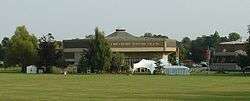
The city holds an annual four-week arts and music festival ("Festival of Chichester")[42] held in June and July.
Chichester Festival Theatre,[43] is one of the United Kingdom's flagship producing and touring theatres, whose annual summer season attracts actors, writers and directors from the West End theatre and the USA.
Pallant House Gallery,[44] winner of the 2007 gallery of the year Gulbenkian Prize, has a major collection of chiefly modern British art and in 2006 opened a new extension that houses the collection of Professor Sir Colin St John Wilson. It has a changing programme of exhibitions.
Chichester is home to the South Downs Planetarium & Science Centre, which opened in 2001 and features a program of public star shows in its 100-seat theatre.
The Sloe Fair, a funfair that dates back to the 12th Century, is held annually on 20 October in the city's Northgate car park.[45]
Chichester Cinema at New Park[46] is the city's first and only arthouse cinema. It shows a selection of mainstream, small-budget and older films 7 days a week. It hosts an annual 18-day International Film Festival in August/September. Vice-presidents are Dame Maggie Smith and Kenneth Branagh. There is a larger, multiplex cinema located at Chichester Gate.
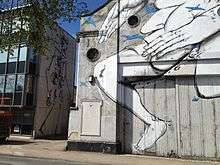
The Chichester Open Mic has supported regular programmes of readings by contemporary poets in the city since 2010. It also hosts a high-profile annual event under the banner Poetry and All That Jazz which included performances by Don Paterson in 2010, Sam Willetts in 2011 and David Harsent in 2012.[47]
In 2012 The Novium, Chichester's museum, was opened by author Kate Mosse.[48] Designed by the architect Keith Williams, is approximately 2.4 times the size of the previous museum in Little London. Key highlights are Roman Bath House, Jupiter Stone and Chilgrove Mosaic.
In May 2013 Chichester hosted the Chichester Street Art Festival week where international street artists created colourful murals around the city.[49]
Chichester is mentioned in a 1992 episode of A Bit of Fry and Laurie, the 2003 film Bright Young Things directed by Stephen Fry, the 2005 film Stoned about Brian Jones from the Rolling Stones, and also in the 2009 film Sherlock Holmes. The city is periodically referred to in Call the Midwife, as the seat of the Order of Saint Raymond Nonnatus, the mother house's exterior being depicted in episode 1.6.
The West Sussex Record Office is in Orchard Street and contains the county archives. On 21 April 2017 it was announced that a second parchment manuscript copy of the United States Declaration of Independence, now termed The Sussex Declaration, had been discovered in the archives.[50][51]
Music
Founded in 1881, the Chichester Symphony Orchestra has both amateur and professional players. Three concerts are given each year with the summer concert being part of the Chichester Festivities while the autumn concert is included in the Chichester Cathedral Lunchtime Series.
The Chichester RAJF (From "Real Ale and Jazz Festival"), was a four-day festival of music and real ale held each July in tents beside the 13th century Guildhall in Priory Park.[52] Founded in 1980 by members of Chichester Hockey Club as a fund-raising event, the festival's early years focused on traditional jazz and featured performers such as Kenny Ball, Humphrey Lyttelton and Kenny Baker. In the 1990s blues and R&B were introduced and acts including James Brown, Status Quo, Blondie, Boney M, Howard Jones, Go West, The Pretenders, The Drifters and Simple Minds played the festival up until its final staging, in 2011.
Sport
Chichester City F.C. is the main football club and are based at Oaklands Park. They play in the Sussex County League.[53] The rugby club, Chichester R.F.C., are also based at Oaklands Park.[54]
Chichester Priory Park Cricket Club and Chichester Priory Park Hockey Club share a clubhouse at Priory Park.[55][56]
The city is home to the Chichester Sharks Flag American Football Club who are members of the BAFA National League.[57] In October 2007, the Sharks won the National Championship, beating Andover Voodoo 31–29 in the final. The Chichester Sharks also won the title in 2003.
Chichester Falcons Softball Club, based at Oaklands Park, play in the Solent Softball League.
Chichester Bowls Club in Priory Park is the oldest established bowls club in Sussex, being founded in 1881.
The city has a leisure centre with swimming pool, flume, sports hall and fitness room; Chichester Cormorants swimming club is based there. Chichester Runners and A.C is a club with runners and athletes from all ages. Other sports include cycling.[58]
Notable people
William Juxon, born 1582, attended The Prebendal School before studying at Oxford. He became chaplain to Charles I and was the last English cleric to hold both church and secular high office. He became Archbishop of Canterbury following the Restoration.[59] William Cawley, born 1602 in Chichester, was on the other side of the English Civil War. Also educated at Oxford University he became the Member of Parliament for Chichester in 1628 and for Midhurst in 1640. He was a regicide and served on the Council of State during the Commonwealth, being forced to flee to Switzerland after the Restoration.[60] A later MP for the town, William Huskisson was one of the earlier people to die from a railway accident, when he was run over by Stephenson's Rocket at the opening of the Liverpool and Manchester Railway. In modern times middle-distance runner Christopher Chataway was elected to Parliament in 1969.[61]
Military people have included Edric Gifford, 3rd Baron Gifford who won a Victoria Cross during the Third Anglo-Ashanti War. General Charles Harington Harington served in the Second Boer War and as a staff officer throughout World War I,[62] and military theorist Major General J. F. C. Fuller planned the first large scale tank assault at the Battle of Cambrai in 1917.[63]
Artists who were born or lived most of their lives in Chichester include Richard Buckner, Heywood Hardy, James Hayllar, William Shayer and George Smith.[64][65] Author Kate Mosse (born 1961) studied at Chichester High School For Girls, living in Chichester until moving to Oxford to attend New College. She is author of the first main-stage new play by a woman at Chichester Festival Theatre, an adaptation of her novel The Taxidermist's Daughter, set in and around Chichester.[66]
Timothy Peake, who became the first official British astronaut when he arrived on the International Space Station in December 2015, was born in Chichester in 1972. Peake attended the Chichester High School for Boys,[67][68] which now has a Sports and Conference centre named after him and opened by him.
Tom Odell, who was born in Chichester, is a songwriter who gained success with his album, Wrong Crowd.
Edward Bradford Titchener (/ˈtiːtʃənər/; 11 January 1867 – 3 August 1927) was a British psychologist who studied under Wilhelm Wundt. Born in Chichester, Titchener created the school of thought in psychology that described the structure of the mind: structuralism.[69]
Joel Ward, footballer for Crystal Palace F.C., studied at Bishop Luffa School and was born in nearby Emsworth.
Town twinning
The City of Chichester is twinned with Chartres, France since February 1959 and Ravenna, Italy since December 1996.[70][71] Friendship links have also been established with Marktredwitz in Germany, Kursk in Russia and Valletta in Malta.[71]
Arms
 |
|
References
- "2001 Census: West Sussex – Population by Parish" (PDF). West Sussex County Council. Archived from the original (PDF) on 8 June 2011. Retrieved 12 April 2009.
- "2011 Census: Chichester (Parish)". Office for National Statistics. Archived from the original on 2 April 2015.
- "BBC - Domesday Reloaded: CHICHESTER-A CICESTRIAN". Domesday. Archived from the original on 20 March 2012. Retrieved 16 November 2013.
- OS Explorer map 120: Chichester, South Harting and Selsey Scale: 1:25 000. Publisher:Ordnance Survey – Southampton B2 edition. Publishing Date:2009. ISBN 978 0319240793
- Manley, John (2007). AD43: The Roman Invasion of Britain. Tempus Publishing. pp. 111–128. ISBN 978-0-7524-1959-6.
- "Chichester Roman houses found under Priory Park". 26 January 2017. Archived from the original on 26 January 2017. Retrieved 26 January 2017.
- Gower, Graham, London Archaeologist Winter 2002, pp 59–63
- "Chichester | Domesday Book". Open Domesday. Archived from the original on 27 September 2017. Retrieved 31 May 2017.
- Historic England. "Chichester Castle (1386089)". PastScape. Retrieved 10 May 2011.
- Chichester District Council, Castle, Chichester.gov.uk, archived from the original on 16 October 2007, retrieved 21 May 2009
- "Victoria County History – The rape of Chichester". British History Online. Archived from the original on 24 October 2012. Retrieved 31 July 2010.
- Historic England. "CHURCH OF ST PANCRAS, Chichester (1354343)". National Heritage List for England. Retrieved 1 March 2019.
- "Roussillon Barracks". Royal Sussex. Archived from the original on 2 October 2013. Retrieved 16 November 2014.
- "Social hub revealed for Roussillon Park". chichester.co.uk. Archived from the original on 8 April 2015. Retrieved 18 January 2015.
- "The City of Chichester: Historical introduction - British History Online". www.british-history.ac.uk. Archived from the original on 7 October 2018. Retrieved 9 October 2018.
- 2018, Access by Design. "Chichester City Council - The Parish Council for the City of Chichester". chichestercity.gov.uk. Archived from the original on 7 May 2018. Retrieved 9 October 2018.CS1 maint: numeric names: authors list (link)
- "City councillors". Chichestercity.gov.uk. 16 May 2007. Archived from the original on 1 September 2009. Retrieved 16 July 2010.
- "Chichester City Council: The Council House". Archived from the original on 29 December 2017. Retrieved 28 December 2017.
- "UK Parliament website". Archived from the original on 17 November 2017. Retrieved 5 December 2017.
- "British History Online". British-history.ac.uk. 22 June 2003. Archived from the original on 27 September 2007. Retrieved 16 July 2010.
- Sub-Urban website: River Lavant Archived 10 May 2008 at the Wayback Machine
- "City Walls Walk: includes map". Chichesterweb.co.uk. Archived from the original on 26 September 2011. Retrieved 16 July 2010.
- "Chichester Council Conservation Areas". Chichester.gov.uk. Archived from the original on 14 June 2011. Retrieved 16 July 2010.
- "Bognor Regis the sunniest spot in Britain". Telegraph. 28 December 2011. Archived from the original on 6 December 2011. Retrieved 28 December 2011.
- "The Chichester Guide". Chichester Web. Archived from the original on 22 July 2010. Retrieved 16 July 2010.
- "Creating a Prosperous and Sustainable Economy: An Economic Strategy for Chichester District 2013-2019". Archived from the original on 3 October 2018. Retrieved 3 October 2018.
- "The Corn Exchange". Chichester.gov.uk. Archived from the original on 14 June 2011. Retrieved 16 July 2010.
- "The Novium: Chichester Corn Exchange". Archived from the original on 1 December 2017. Retrieved 20 November 2017.
- Row, Ken. "Cinema Treasures: Granada Chichester". Archived from the original on 24 October 2015. Retrieved 20 November 2017.
- "Changing Times - Old corn market house has changed hands a few times going back to the 18th century". "Chichester Post. 9 June 2017. Archived from the original on 1 December 2017. Retrieved 20 November 2017.
- "Fashion retailer Next to move into former MacDonalds site". Chichester Observer. 23 June 2005. Archived from the original on 1 December 2017. Retrieved 20 November 2017.
- "Chichester City Cross". West Sussex.info. Archived from the original on 6 January 2011. Retrieved 1 September 2010.
- "''Chichester Web': churches of Chichester". Chichesterweb.co.uk. Archived from the original on 26 September 2011. Retrieved 16 July 2010.
- Historic England (2011). "Former Church of St John the Evangelist, St John's Street (East Side), Chichester, Chichester, West Sussex (1026696)". National Heritage List for England. Retrieved 28 April 2011.
- Beevers, David; Marks, Richard; Roles, John (1989). Sussex Churches and Chapels. Brighton: The Royal Pavilion, Art Gallery and Museums. p. 58. ISBN 0-948723-11-4.
- "Stagecoach Chichester network map" (PDF). Archived (PDF) from the original on 16 January 2017. Retrieved 14 January 2017.
- "Bus Timetables Compass Travel - Compass Travel". www.compass-travel.co.uk. Archived from the original on 16 January 2017. Retrieved 14 January 2017.
- "Emsworth & District". www.emsworthanddistrict.co.uk. Archived from the original on 18 January 2017. Retrieved 14 January 2017.
- "Explore our timetables - National Express Coaches" (PDF). www.nationalexpress.com. Archived from the original (PDF) on 16 January 2017. Retrieved 14 January 2017.
- They are the Jessie Younghusband Primary School; Kingsham Primary School; Parklands Community School; Chichester Free School, Portfield Community Primary and Singleton C of E Primary School
- The establishment was initially called Bishop Otter College, although throughout its history it has had many names: West Sussex Institute of Higher Education, then Chichester Institute of Higher Education, then University College Chichester
- "Festival of Chichester". 17 May 2013. Archived from the original on 6 May 2013. Retrieved 17 May 2013.
- "The Website of Chichester Festival Theatre". Cft.org.uk. Archived from the original on 1 October 2009. Retrieved 16 July 2010.
- "Pallant House Gallery". Pallant.org.uk. Archived from the original on 20 February 2010. Retrieved 16 July 2010.
- "BBC - Domesday Reloaded: CHICHESTER'S SLOE FAIR". domesday. Archived from the original on 20 March 2012. Retrieved 20 July 2013.
- "Chichester Cinema at New Park". Chichestercinema.org. Archived from the original on 14 July 2010. Retrieved 16 July 2010.
- "Chichester Open Mic". Archived from the original on 17 May 2013. Retrieved 23 April 2012.
- Chichester District Council. "Kate Mosse to open new museum in Chichester". Archived from the original on 2 February 2014.
- "GALLERY: Chichester Street Art". chichester.co.uk. Archived from the original on 13 January 2014. Retrieved 10 May 2013.
- Wang, Amy B. (24 April 2017). "A rare copy of the Declaration of Independence has been found — in England". Washington Post. Archived from the original on 4 July 2018. Retrieved 4 July 2018.
- Moore, Ben (video). "Declaration of Independence found in Chichester archives". BBC. Archived from the original on 4 July 2018. Retrieved 4 July 2018.
- "Chichester RAJF website". Chichester-raja.com. Archived from the original on 19 April 2014. Retrieved 16 July 2010.
- "Chichester City FC website". Ccufc.co.uk. Archived from the original on 9 October 2010. Retrieved 16 July 2010.
- "Chichester RFC website". Chichesterrfc.co.uk. 26 June 2010. Archived from the original on 26 August 2009. Retrieved 16 July 2010.
- "Chichester Priory Park Cricket Club". Archived from the original on 18 May 2013. Retrieved 17 March 2013.
- "Chichester Priory Park Hockey Club". Archived from the original on 11 April 2013. Retrieved 17 March 2013.
- "Chichester Sharks flag American football website". Chichestersharks.co.uk. Archived from the original on 14 August 2010. Retrieved 16 July 2010.
- "Southdown Velo cycling club". Southdownvelo.org.uk. 12 July 2010. Archived from the original on 4 July 2010. Retrieved 16 July 2010.
- Mason, Thomas (1985). Serving God and Mammon: William Juxon, 1582–1663. ISBN 978-0-87413-251-9.
- T. Peacey, ‘Cawley, William (bap. 1602, d. 1667)’, Oxford Dictionary of National Biography, Oxford University Press, 2004; online edn, Jan 2008
- "Hansard". 19 January 1972. Archived from the original on 24 July 2018. Retrieved 27 May 2019.
- Powell, Geoffrey S. (September 2004). "Harington, Sir Charles (1872–1940)". Oxford Dictionary of National Biography (May 2006 ed.). doi:10.1093/ref:odnb/33712. Archived from the original on 4 March 2016. Retrieved 24 January 2008.(subscription required)
- Tucker, Spencer C., The European Powers in the First World War: An Encyclopedia, Routledge, 2013, ISBN 1135507015, p. 280
- Stewart, Brian; Cutten, Mervyn (1987). Chichester Artists. Canterbury, Kent: Bladon Press. ISBN 0-9512814-0-2.
- Hardy, Kimber G. (2016). The Hardy Family of Artists: Frederick Daniel, George, Heywood, James and their descendants. Woodbridge, Suffolk: ACC Art Books. pp. 68–155. ISBN 978-185149-826-0.
- https://www.cft.org.uk/whats-on/event/the-taxidermists-daughter
- Bremner, Charles; Henderson, Mark; Devlin, Hannah (20 May 2009). "Briton Major Timothy Peake named as Europe's latest astronaut". London: Times Online. Retrieved 27 March 2010.
- "PEAKE, Timothy Nigel". Who's Who. ukwhoswho.com. 2016 (online Oxford University Press ed.). A & C Black, an imprint of Bloomsbury Publishing plc. (subscription or UK public library membership required) (subscription required)
- Proctor, Robert W; Evans, Rand (Winter 2014). "E. B. Titchener, Women Psychologists and the Experimentalists". American Journal of Psychology. 127 (4): 501–526.
- "British towns twinned with French towns [via WaybackMachine.com]". Archant Community Media Ltd. Archived from the original on 5 July 2013. Retrieved 20 July 2013.
- "Twinning". Chichester City Council. Archived from the original on 2 October 2017. Retrieved 27 May 2019.
- "Civic Heraldry of England". Robert Young. Retrieved 12 March 2019.
Bibliography
- Down, Alec (1988). Roman Chichester. Chichester: Phillimore. ISBN 0-85033-435-7.
- Sharp, Thomas (1949). Georgian City: A plan for the preservation and improvement of Chichester. London: The Architectural Press.
External links
| Wikimedia Commons has media related to Chichester. |
| Wikivoyage has a travel guide for Chichester. |
- Chichester District Council
- British History Online - The City of Chichester - Historical Introduction
- . New International Encyclopedia. 1905.